Abstract
A disulfide bond that is evidently conserved in the guanine nucleotide-binding protein-coupled receptors is present in rhodopsin between Cys-110 and Cys-187. We have replaced these two cysteine residues by alanine residues and now report on the properties of the resulting rhodopsin mutants. The mutant protein C110A/C187A expressed in COS cells resembles wild-type rhodopsin in the ground state. It folds correctly to bind 11-cis-retinal and form the characteristic rhodopsin chromophore. It is inert to hydroxylamine in the dark, and its stability to dark thermal decay is reduced, relative to that of the wild type, by a delta delta G not equal to of only -2.9 kcal/mol. Further, the affinities of the mutant and wild-type rhodopsins to the antirhodopsin antibody rho4D2 are similar, both in the dark and in light. However, the metarhodopsin II (MII) and MIII photointermediates of the mutant are less stable than those formed by the wild-type rhodopsin. Although the initial rates of transducin activation are the same for both mutant and wild-type MII intermediates at 4 degrees C, at 15 degrees C the MII photointermediate in the mutant decays more than 20 times faster than in wild type. We conclude that the disulfide bond between Cys-110 and Cys-187 is a key component in determining the stability of the MII structure and its coupling to transducin activation.
Full text
PDF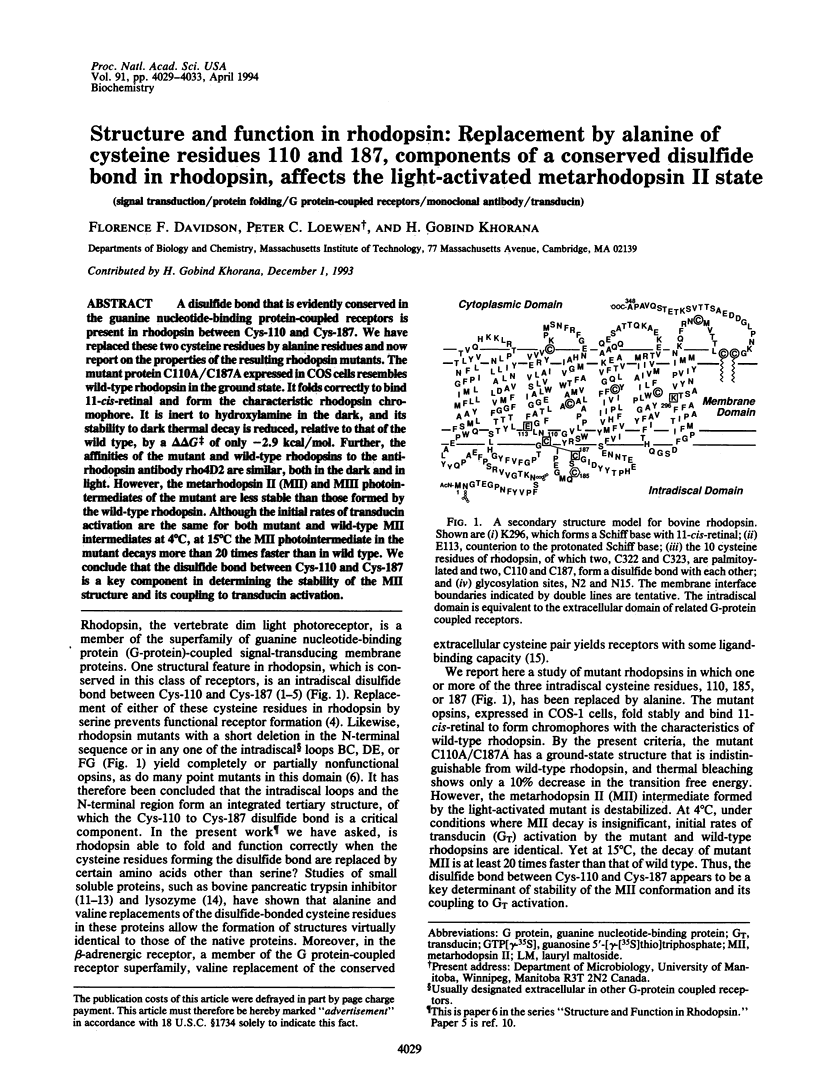
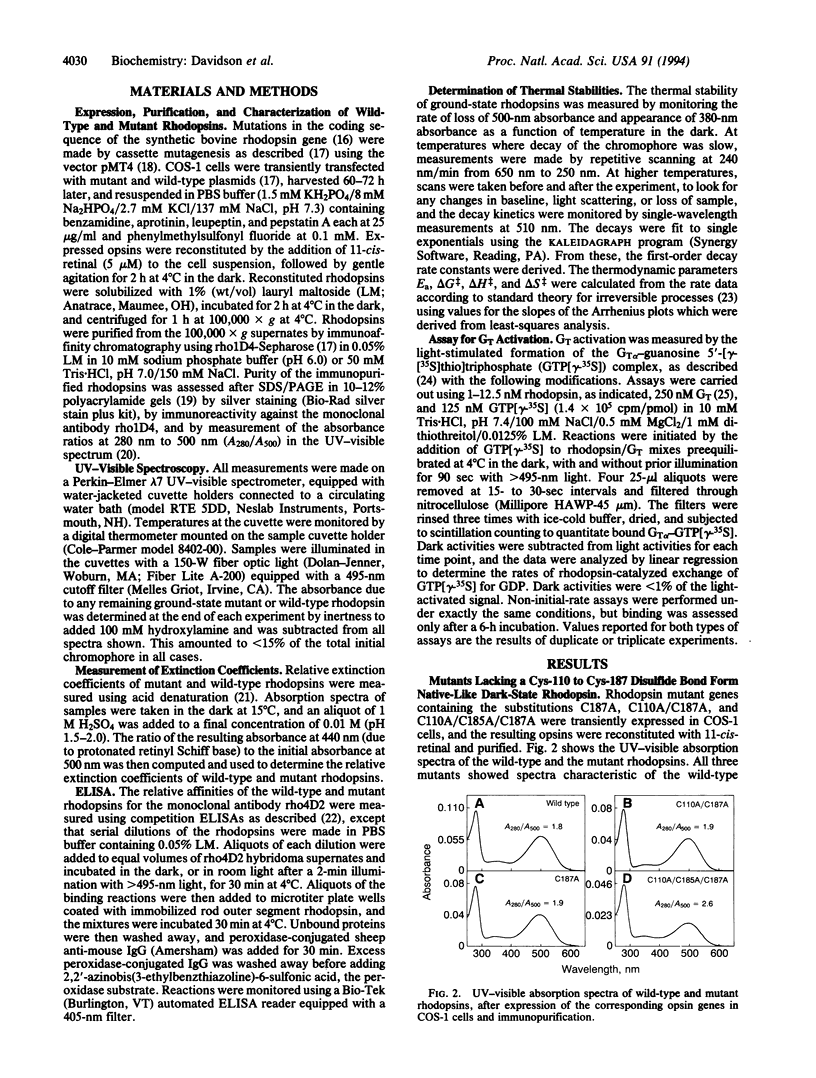
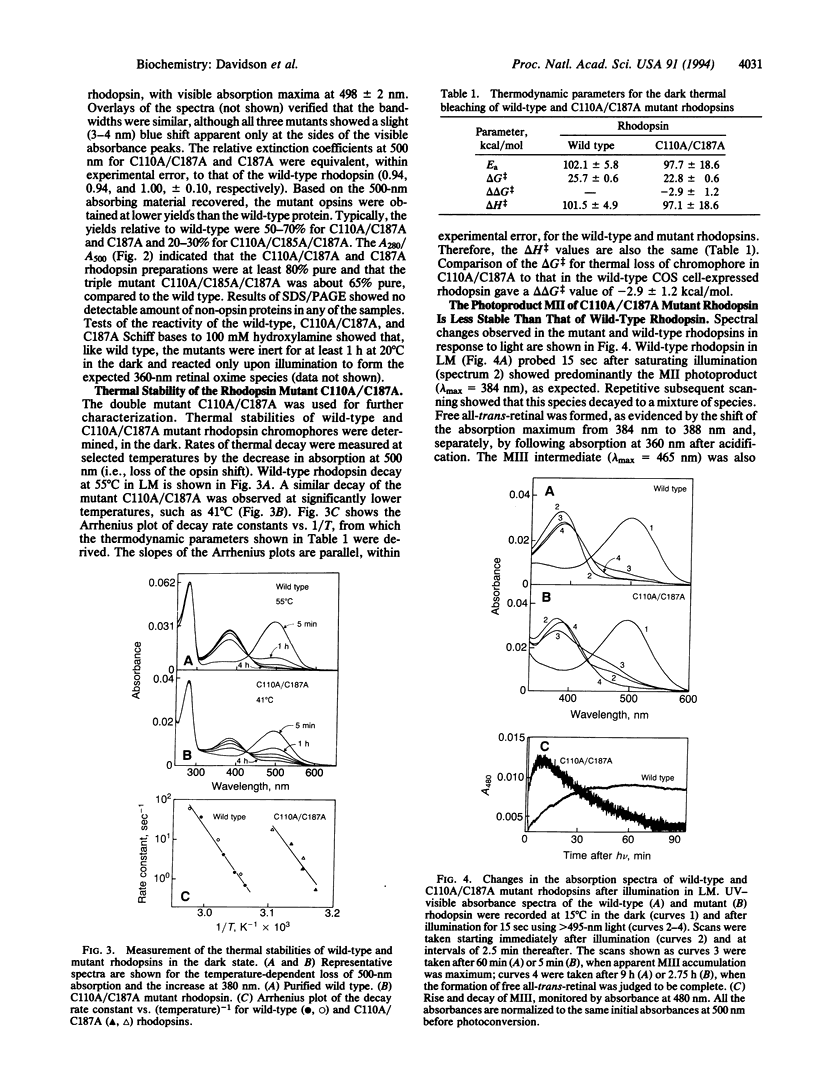
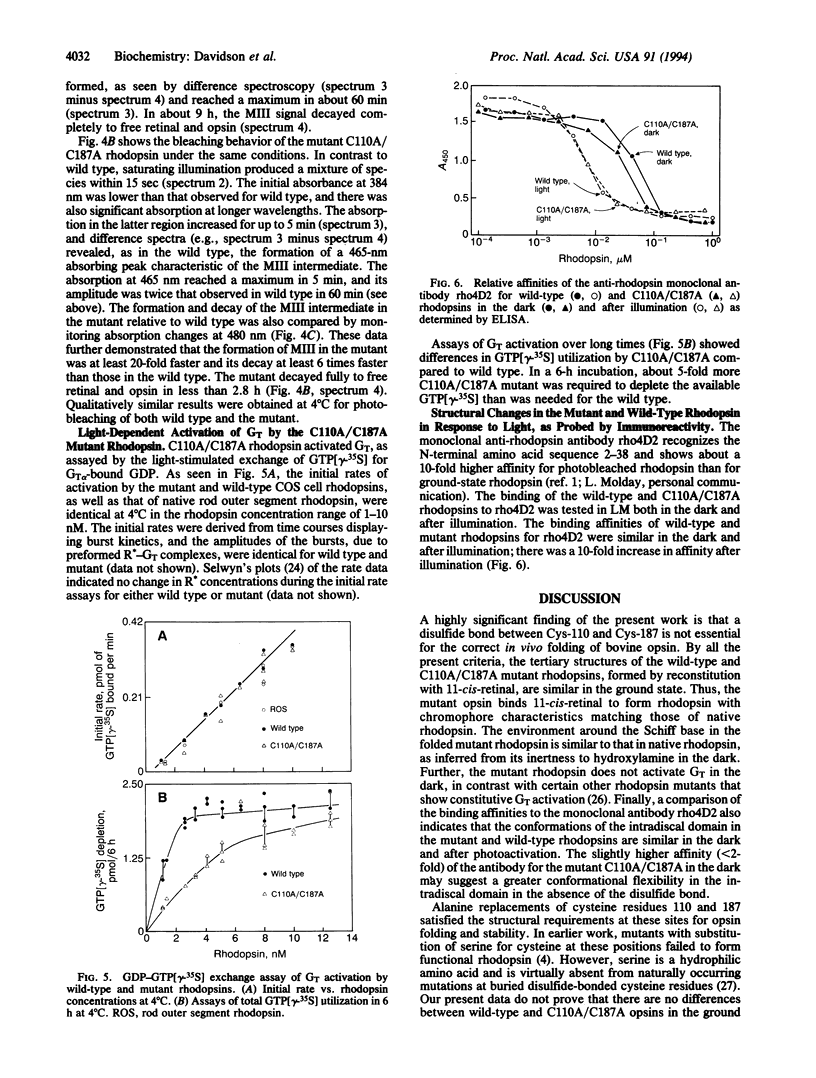
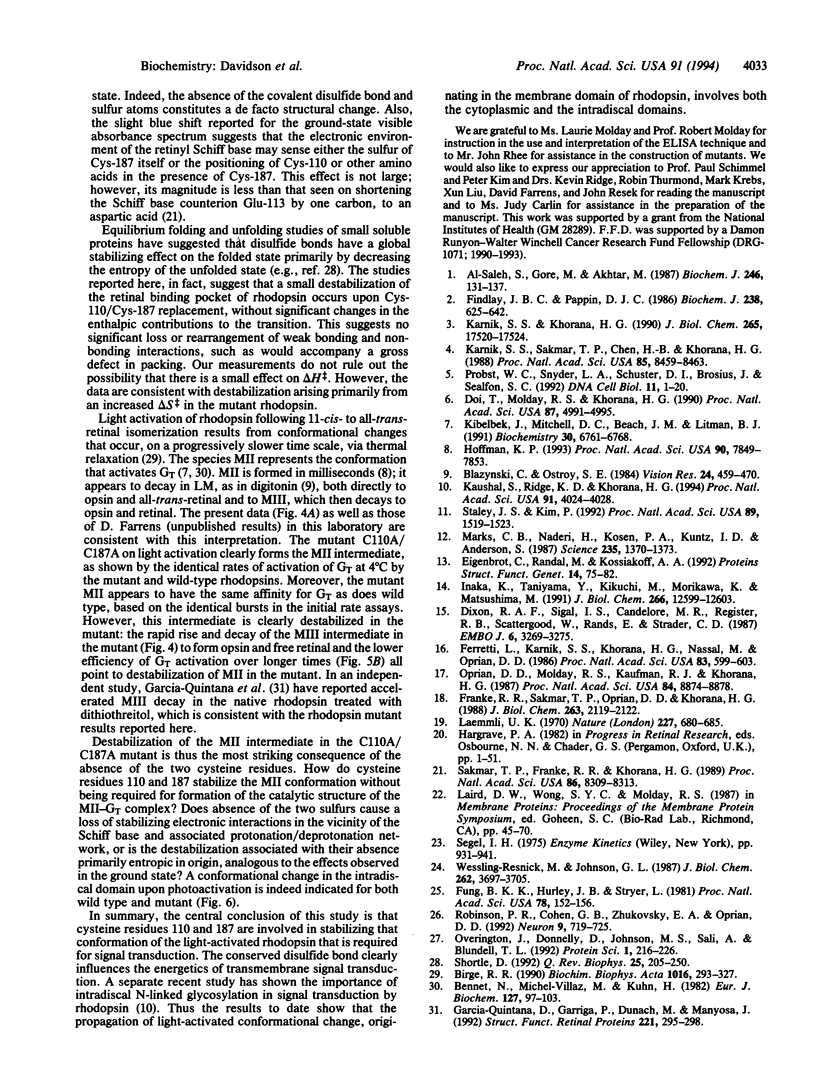
Selected References
These references are in PubMed. This may not be the complete list of references from this article.
- Al-Saleh S., Gore M., Akhtar M. On the disulphide bonds of rhodopsins. Biochem J. 1987 Aug 15;246(1):131–137. doi: 10.1042/bj2460131. [DOI] [PMC free article] [PubMed] [Google Scholar]
- Arnis S., Hofmann K. P. Two different forms of metarhodopsin II: Schiff base deprotonation precedes proton uptake and signaling state. Proc Natl Acad Sci U S A. 1993 Aug 15;90(16):7849–7853. doi: 10.1073/pnas.90.16.7849. [DOI] [PMC free article] [PubMed] [Google Scholar]
- Bennett N., Michel-Villaz M., Kühn H. Light-induced interaction between rhodopsin and the GTP-binding protein. Metarhodopsin II is the major photoproduct involved. Eur J Biochem. 1982 Sep;127(1):97–103. doi: 10.1111/j.1432-1033.1982.tb06842.x. [DOI] [PubMed] [Google Scholar]
- Birge R. R. Nature of the primary photochemical events in rhodopsin and bacteriorhodopsin. Biochim Biophys Acta. 1990 Apr 26;1016(3):293–327. doi: 10.1016/0005-2728(90)90163-x. [DOI] [PubMed] [Google Scholar]
- Blazynski C., Ostroy S. E. Pathways in the hydrolysis of vertebrate rhodopsin. Vision Res. 1984;24(5):459–470. doi: 10.1016/0042-6989(84)90043-9. [DOI] [PubMed] [Google Scholar]
- Dixon R. A., Sigal I. S., Candelore M. R., Register R. B., Scattergood W., Rands E., Strader C. D. Structural features required for ligand binding to the beta-adrenergic receptor. EMBO J. 1987 Nov;6(11):3269–3275. doi: 10.1002/j.1460-2075.1987.tb02645.x. [DOI] [PMC free article] [PubMed] [Google Scholar]
- Doi T., Molday R. S., Khorana H. G. Role of the intradiscal domain in rhodopsin assembly and function. Proc Natl Acad Sci U S A. 1990 Jul;87(13):4991–4995. doi: 10.1073/pnas.87.13.4991. [DOI] [PMC free article] [PubMed] [Google Scholar]
- Eigenbrot C., Randal M., Kossiakoff A. A. Structural effects induced by mutagenesis affected by crystal packing factors: the structure of a 30-51 disulfide mutant of basic pancreatic trypsin inhibitor. Proteins. 1992 Sep;14(1):75–87. doi: 10.1002/prot.340140109. [DOI] [PubMed] [Google Scholar]
- Ferretti L., Karnik S. S., Khorana H. G., Nassal M., Oprian D. D. Total synthesis of a gene for bovine rhodopsin. Proc Natl Acad Sci U S A. 1986 Feb;83(3):599–603. doi: 10.1073/pnas.83.3.599. [DOI] [PMC free article] [PubMed] [Google Scholar]
- Findlay J. B., Pappin D. J. The opsin family of proteins. Biochem J. 1986 Sep 15;238(3):625–642. doi: 10.1042/bj2380625. [DOI] [PMC free article] [PubMed] [Google Scholar]
- Franke R. R., Sakmar T. P., Oprian D. D., Khorana H. G. A single amino acid substitution in rhodopsin (lysine 248----leucine) prevents activation of transducin. J Biol Chem. 1988 Feb 15;263(5):2119–2122. [PubMed] [Google Scholar]
- Fung B. K., Hurley J. B., Stryer L. Flow of information in the light-triggered cyclic nucleotide cascade of vision. Proc Natl Acad Sci U S A. 1981 Jan;78(1):152–156. doi: 10.1073/pnas.78.1.152. [DOI] [PMC free article] [PubMed] [Google Scholar]
- Inaka K., Taniyama Y., Kikuchi M., Morikawa K., Matsushima M. The crystal structure of a mutant human lysozyme C77/95A with increased secretion efficiency in yeast. J Biol Chem. 1991 Jul 5;266(19):12599–12603. [PubMed] [Google Scholar]
- Karnik S. S., Khorana H. G. Assembly of functional rhodopsin requires a disulfide bond between cysteine residues 110 and 187. J Biol Chem. 1990 Oct 15;265(29):17520–17524. [PubMed] [Google Scholar]
- Karnik S. S., Sakmar T. P., Chen H. B., Khorana H. G. Cysteine residues 110 and 187 are essential for the formation of correct structure in bovine rhodopsin. Proc Natl Acad Sci U S A. 1988 Nov;85(22):8459–8463. doi: 10.1073/pnas.85.22.8459. [DOI] [PMC free article] [PubMed] [Google Scholar]
- Kaushal S., Ridge K. D., Khorana H. G. Structure and function in rhodopsin: the role of asparagine-linked glycosylation. Proc Natl Acad Sci U S A. 1994 Apr 26;91(9):4024–4028. doi: 10.1073/pnas.91.9.4024. [DOI] [PMC free article] [PubMed] [Google Scholar]
- Kibelbek J., Mitchell D. C., Beach J. M., Litman B. J. Functional equivalence of metarhodopsin II and the Gt-activating form of photolyzed bovine rhodopsin. Biochemistry. 1991 Jul 9;30(27):6761–6768. doi: 10.1021/bi00241a019. [DOI] [PubMed] [Google Scholar]
- Laemmli U. K. Cleavage of structural proteins during the assembly of the head of bacteriophage T4. Nature. 1970 Aug 15;227(5259):680–685. doi: 10.1038/227680a0. [DOI] [PubMed] [Google Scholar]
- Marks C. B., Naderi H., Kosen P. A., Kuntz I. D., Anderson S. Mutants of bovine pancreatic trypsin inhibitor lacking cysteines 14 and 38 can fold properly. Science. 1987 Mar 13;235(4794):1370–1373. doi: 10.1126/science.2435002. [DOI] [PubMed] [Google Scholar]
- Oprian D. D., Molday R. S., Kaufman R. J., Khorana H. G. Expression of a synthetic bovine rhodopsin gene in monkey kidney cells. Proc Natl Acad Sci U S A. 1987 Dec;84(24):8874–8878. doi: 10.1073/pnas.84.24.8874. [DOI] [PMC free article] [PubMed] [Google Scholar]
- Overington J., Donnelly D., Johnson M. S., Sali A., Blundell T. L. Environment-specific amino acid substitution tables: tertiary templates and prediction of protein folds. Protein Sci. 1992 Feb;1(2):216–226. doi: 10.1002/pro.5560010203. [DOI] [PMC free article] [PubMed] [Google Scholar]
- Probst W. C., Snyder L. A., Schuster D. I., Brosius J., Sealfon S. C. Sequence alignment of the G-protein coupled receptor superfamily. DNA Cell Biol. 1992 Jan-Feb;11(1):1–20. doi: 10.1089/dna.1992.11.1. [DOI] [PubMed] [Google Scholar]
- Robinson P. R., Cohen G. B., Zhukovsky E. A., Oprian D. D. Constitutively active mutants of rhodopsin. Neuron. 1992 Oct;9(4):719–725. doi: 10.1016/0896-6273(92)90034-b. [DOI] [PubMed] [Google Scholar]
- Sakmar T. P., Franke R. R., Khorana H. G. Glutamic acid-113 serves as the retinylidene Schiff base counterion in bovine rhodopsin. Proc Natl Acad Sci U S A. 1989 Nov;86(21):8309–8313. doi: 10.1073/pnas.86.21.8309. [DOI] [PMC free article] [PubMed] [Google Scholar]
- Shortle D. Mutational studies of protein structures and their stabilities. Q Rev Biophys. 1992 May;25(2):205–250. doi: 10.1017/s0033583500004674. [DOI] [PubMed] [Google Scholar]
- Staley J. P., Kim P. S. Complete folding of bovine pancreatic trypsin inhibitor with only a single disulfide bond. Proc Natl Acad Sci U S A. 1992 Mar 1;89(5):1519–1523. doi: 10.1073/pnas.89.5.1519. [DOI] [PMC free article] [PubMed] [Google Scholar]
- Wessling-Resnick M., Johnson G. L. Allosteric behavior in transducin activation mediated by rhodopsin. Initial rate analysis of guanine nucleotide exchange. J Biol Chem. 1987 Mar 15;262(8):3697–3705. [PubMed] [Google Scholar]


